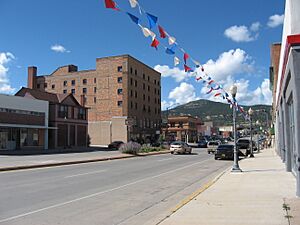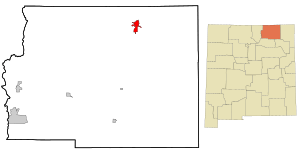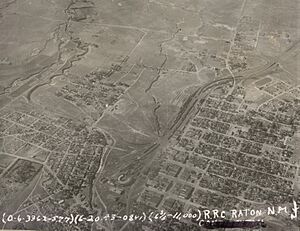Raton, New Mexico facts for kids
Quick facts for kids
Raton, New Mexico
|
|
|---|---|

Downtown Raton
|
|

Location within Colfax County and New Mexico
|
|
| Country | United States |
| State | New Mexico |
| County | Colfax |
| Area | |
| • Total | 7.96 sq mi (20.62 km2) |
| • Land | 7.96 sq mi (20.62 km2) |
| • Water | 0.00 sq mi (0.00 km2) |
| Elevation | 6,559 ft (1,999 m) |
| Population
(2020)
|
|
| • Total | 6,041 |
| • Density | 759/sq mi (293/km2) |
| Time zone | UTC−7 (Mountain (MST)) |
| • Summer (DST) | UTC−6 (MDT) |
| ZIP code |
87740
|
| Area code | 575 |
| FIPS code | 35-62060 |
| GNIS feature ID | 2411522 |
Raton is a city in northeastern New Mexico, United States. It's the main city, or county seat, of Colfax County. You can find Raton just south of Raton Pass, close to the border with Colorado. It's also about 85 miles west of Texas. In 2020, about 6,041 people lived there.
Contents
A Look at Raton's Past
The name Ratón means "mouse" in Spanish.
For hundreds of years, Spanish explorers and Native Americans used Raton Pass. It was a key route through the tough Rocky Mountains. The mountain part of the Santa Fe Trail also goes through the city. Today, this path is part of Business I-25.
The area where Raton now stands was once a stop on the Santa Fe Trail called Willow Springs. In 1880, the land for Raton was bought. The Atchison, Topeka and Santa Fe Railway bought a local toll road in 1879. They then built a busy train line. Raton quickly grew into an important center for railroads, mining, and ranching. It became the county seat and a main trading spot for the area.
Raton's Location and Land
Raton covers about 20.6 square kilometers (7.96 square miles) of land. There is no water area within the city limits. The Raton Range and Raton Peak are just north of the town. The Raton Range is a long ridge that stretches about 75 miles (120 km) east from the Sangre de Cristo Mountains. Raton Pass and the Raton Basin are also named after the Raton Range.
Understanding Raton's Geology
You can see a special rock layer in Raton called the Cretaceous–Paleogene boundary. It's also known as the K-Pg or K-T boundary. This layer is important because it shows evidence of a huge meteorite impact. Scientists believe this impact caused the Cretaceous–Paleogene extinction event. This event led to the death of dinosaurs and many other plants and animals about 66 million years ago.
Raton's Climate
| Climate data for Raton, New Mexico (elevation 6,680 feet or 2,040 metres) | |||||||||||||
|---|---|---|---|---|---|---|---|---|---|---|---|---|---|
| Month | Jan | Feb | Mar | Apr | May | Jun | Jul | Aug | Sep | Oct | Nov | Dec | Year |
| Record high °F (°C) | 80 (27) |
81 (27) |
86 (30) |
91 (33) |
95 (35) |
104 (40) |
102 (39) |
99 (37) |
99 (37) |
90 (32) |
85 (29) |
82 (28) |
104 (40) |
| Mean daily maximum °F (°C) | 47.2 (8.4) |
48.6 (9.2) |
56.3 (13.5) |
64.6 (18.1) |
72.7 (22.6) |
82.3 (27.9) |
86.2 (30.1) |
84.5 (29.2) |
77.9 (25.5) |
68.4 (20.2) |
56.7 (13.7) |
48.2 (9.0) |
66.1 (18.9) |
| Mean daily minimum °F (°C) | 14.9 (−9.5) |
16.7 (−8.5) |
22.1 (−5.5) |
30.1 (−1.1) |
38.9 (3.8) |
47.0 (8.3) |
52.4 (11.3) |
51.9 (11.1) |
43.3 (6.3) |
33.1 (0.6) |
22.5 (−5.3) |
14.8 (−9.6) |
32.3 (0.2) |
| Record low °F (°C) | −21 (−29) |
−17 (−27) |
−11 (−24) |
12 (−11) |
23 (−5) |
37 (3) |
45 (7) |
45 (7) |
26 (−3) |
12 (−11) |
−10 (−23) |
−14 (−26) |
−21 (−29) |
| Average precipitation inches (mm) | 0.35 (8.9) |
0.55 (14) |
0.72 (18) |
1.68 (43) |
2.17 (55) |
2.22 (56) |
2.91 (74) |
2.36 (60) |
1.93 (49) |
1.09 (28) |
0.57 (14) |
0.44 (11) |
16.99 (430.9) |
| Average snowfall inches (cm) | 3.5 (8.9) |
6.5 (17) |
5.7 (14) |
4.0 (10) |
1.7 (4.3) |
0 (0) |
0 (0) |
0 (0) |
0.3 (0.76) |
1.1 (2.8) |
3.6 (9.1) |
4.3 (11) |
30.5 (77) |
| Source: The Western Regional Climate Center | |||||||||||||
Raton's Population Changes
| Historical population | |||
|---|---|---|---|
| Census | Pop. | %± | |
| 1890 | 1,255 | — | |
| 1900 | 3,540 | 182.1% | |
| 1910 | 4,539 | 28.2% | |
| 1920 | 5,544 | 22.1% | |
| 1930 | 6,090 | 9.8% | |
| 1940 | 7,607 | 24.9% | |
| 1950 | 8,241 | 8.3% | |
| 1960 | 8,146 | −1.2% | |
| 1970 | 6,962 | −14.5% | |
| 1980 | 8,225 | 18.1% | |
| 1990 | 7,372 | −10.4% | |
| 2000 | 7,282 | −1.2% | |
| 2010 | 6,885 | −5.5% | |
| 2020 | 6,041 | −12.3% | |
| U.S. Decennial Census | |||
In 2000, Raton had 7,282 people living there. About 78% of the people were White. About 57% of the population were of Hispanic or Latino background.
The population changed over the years. By 2010, it was 6,885 people. In 2020, the population was 6,041.
Fun Things to Do in Raton
Raton hosts a few exciting events each year:
- Run to Raton: This is a motorcycle rally that happens every July. It includes camp-outs, vendors, and free music.
- International Balloon Rally: On the Fourth of July weekend, hot-air balloons fill the sky for this gathering.
Raton was also home to New Mexico's first horse racetrack, La Mesa Park. It closed in 1992.
How to Get Around Raton

Roads
- I-25
- US 64
- US 87
Train Travel
- The Raton Amtrak Station is a stop for the Southwest Chief train route.
Air Travel
- Raton Municipal Airport
Famous People from Raton
Many interesting people have connections to Raton:
- Tom W. Blackburn: A writer who wrote the words to "The Ballad of Davy Crockett".
- Edwin Fullinwider: An Olympic fencer.
- Noel Mazzone: A football coach who worked for the University of Arizona.
- Paul L. Modrich: He won the Nobel Prize in Chemistry in 2015.
- John Morrow: A politician who represented New Mexico in the U.S. Congress.
- John R. Sinnock: An engraver for the United States Mint. He designed the FDR dime.
- Petro Vlahos: A Hollywood special-effects pioneer who won three Academy Awards.
- Robert W. Warren: A former attorney general of Wisconsin.
- Bennie L. Woolley, Jr.: A racehorse trainer who won the 2009 Kentucky Derby.
- The Fireballs: A rock and roll music group known for their song "Bottle of Wine". They started in Raton.
See also
 In Spanish: Ratón (Nuevo México) para niños
In Spanish: Ratón (Nuevo México) para niños


